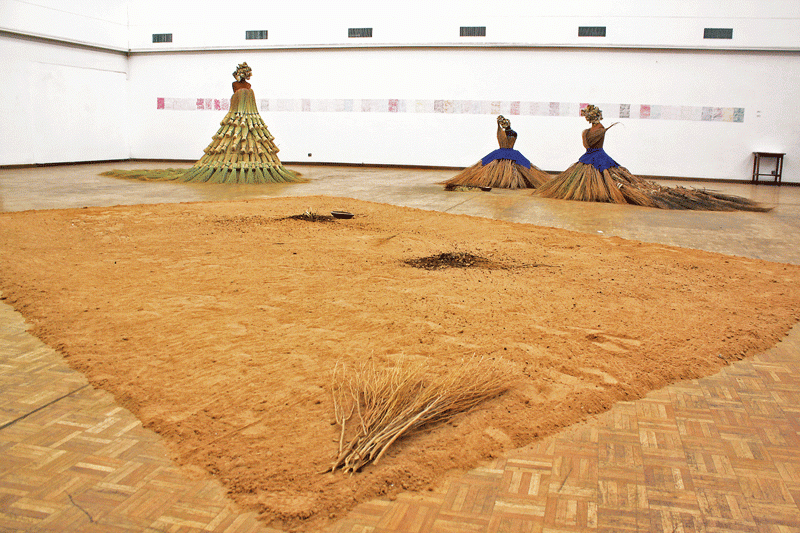
AT the National Gallery of Zimbabwe, Sabina Mutsvati commands the space into a traditional homestead with a stunning installation steeped in folklore. Indigenous people from all walks of life easily comprehend the theme of the exhibition. The materials used make visitors feel both literally and metaphorically at home.
The floor opens with two effigies made from brooms that are used to sweep the yard. Titled Varoora I & II, the female figures appear to be in a kneeling position with their backs to the entrance. On the floor before them is a pile of sweepings, a broom and a bowl containing a single low denomination Zimbabwean banknote.
The vernacular title means daughters-in-law, but the plural form carries special emphasis and gravitas because it denotes a sisterhood of daughters-in-law who interchange and assist each other in their traditional responsibilities.
Further in, an effigy cloaked in cascading fine brooms extends into long train towers above the audience. This dominant figure, titled Vamwene which means mother-in-law, stands tall in contrast to the submissive couple seated on the ground. There is a hint of overruling power, which is sometimes a source of conflict with varoora. It can also be seen as a reflection of how, with time, the subservient daughter-in-law, may become a venerated matriarch.
The exhibition title Ndishonongoreiwo refers to a traditional practice whereby varoora demand compensation for performing ceremonial duties. Most notable is the occasion when a newly-married woman accompanied by her entourage, is handed over to the husband’s family. For a start, she has to be paid (kushonongorwa) for entering the homestead, for entering the house and ultimately for lifting her veil to be introduced.
The following morning, the bride and her company sweep the yard and leave small piles at various spots around the yard and will only take the trash to the pit after a token of appreciation has been paid.
They prepare a bath for the husband’s family by presenting a pail of water, a piece of soap and a towel, for which the recipient is required to pay a token of appreciation. Eventually they prepare a meal which in like manner the hosts are compelled to give a token of appreciation.
Another event where the daughter-in-law demands kushonongorwa is at funerals where they can bar pallbearers from moving the coffin from the house until they get paid. At the cemetery they bring vessels of water and refuse to put them down until their obligations are met. Before leaving the burial site, the women sweep the area around the grave while on their knees and moving backwards to avoid leaving their footprints. When they finish they remain on their knees until vashonongorwa. At the end of a funeral varoora sweep the yard before the mourners disperse. On this occasion they also leave small piles which will only be removed after the obligations are fulfilled.
- Gweje relishes fashion achievements
- Daily life struggles reflected in Burning Figure
- 'Film sector drives economic growth'
- My Beautiful Home contest over subscribed
Keep Reading
An audience engagement part of the exhibition is the work titled My sweeping signature which is a series of sheets of paper marked with sweeping patterns. The work is accompanied with another titled Show us your sweeping signature where blank sheets of paper and different coloured crayons are placed atop a small table. The audience is expected to respond by marking the paper and mounting it on the wall at the end of a long line of previous participants’ responses.
Beyond the fun part, the activation turns the audience into co-exhibitor and builds intimacy. The suggestion that there are different styles of sweeping initiates the unpacking of the phenomenon being explored by the artist.
The sweeping gesture with traditional brooms leaves a distinct mark for each motion of the broom. Brooms meant for indoor use are made from finer materials and leave tight lines when used outside. Those meant for outdoors are made from coarse and strong grass that creates groovy, crooked and spaced lines. Close observation of different styles of sweeping will reveal more information about the subject such as mood and circumstance.
A sweeper, who has run out of time, will usually take long strides that result in longer arcs from trying to cover as much ground as possible in the least amount of time. Where there are scattered leaves the broom carries lighter on the surface leaving shallower grooves than where there is heavier waste materials. Straight lines can be seen at the edge of the compound where sand and small debris are swept into the undergrowth.
Choppy dabbing motions can be used to dislodge grain and other objects embedded into the ground. Small inward motion leaving a circular pattern may be observed where the litter is gathered into a pile. A common statement for a sloppy job is kutsvara or kumaranzura evidenced by erratic and sporadic lines which indicate that the person has barely scratched the ground and has left behind some detritus. A surface that has been swept over will also be marked by footprints of the one who did the job and will reveal if they were barefoot, and type of footwear in other instances.
Another factor to consider in style is how some hold the broom with one hand while others use both. Some will have their free hand folded at the back while others support it on the knee at the opposite side of the body. The broom is also an acoustic instrument that produces varying sounds determined by speed, type of broom and how hard the surface is.
Chivanze I is a long rectangular shape made out of soil with a broom in one corner and two small piles of sweepings. A wooden bowl with a Zimbabwean banknote is placed near one of the piles. It is a straightforward narrative that is mind blowing in its simplicity. Who could have thought that the space outside the doorstep, where everyone steps out first thing in the morning as they go out and last before retiring to bed is a cultural symbol of this magnitude?
Chivanze II is a long piece of painting made from sand on paper, which shows the marking on the ground just after it has been swept. Close inspection also shows bare footprints of the one who completed the task.
Kutsvaira is a video installation showing nine female bodies sweeping. The performative piece demonstrates a sense of rhyme and pays homage to different stages of womanhood as revealed by physical attribute and manner of dressing.
Nguvaira dzemutsvairo I & II is a bold elevation of a humble domestic tool and dominant medium for the show, into a framed "work of art". It feels like a subtle dig on the Western concept of art and the costly foreign materials required for its production.
Ndishonongoreiwo is incomplete in the sense that the audience is not provided with room to respond in kind. Without a commensurate response, the question posed by the exhibition becomes a serious indictment on how society undervalues contributions made by women — and in that sense, there can be no room for virtue signalling.
Mutsvati is a fashion designer and creative director at Dzimbanhete Arts and Culture Interactions. Her ideas are not downloaded from an intellectual ivory tower but bear witness to lived experiences.
Her work is conceptual art that has not traded its soul for the external gaze. Deeply rooted in traditional customs and indigenous knowledge systems Ndishonongoreiwo is prodding, poking and playful yet sincere in its appeal. In the original context, an appropriate response would be correspondingly playful and sincere, with teasing and feigned defiance eventually yielding to mutual submission.







